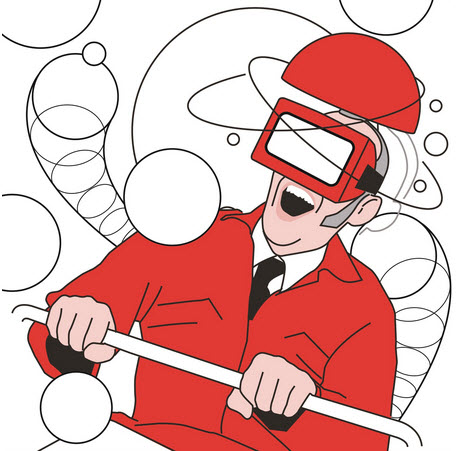Out of their minds: a thrilling ride that adapts to riders’ brain activity
March 13, 2015
A new ride called Neurosis, based on research from The University of Nottingham, adapts the experience to the rider’s own brain activity. Its world premiere will be at the FutureFest festival taking place in London this weekend.
It draws on research being conducted by performance artist/professor Brendan Walker, a principal research fellow in the University’s School of Computer Science, described as the “world’s only Thrill Engineer” by The Times. Walker and academics at the University’s Horizon Digital Economy Research institute are developing novel ways of using biosensors to capture and present data from the human body.
Neurosis features a six-degrees-of-freedom (various kinds of twists and turns) motion simulator and virtual-reality headset to immerse the rider in a surreal environment controlled not by a ride operator but by the rider’s own brain activity. This activity generates an audiovisual virtual world where pathways emerge, tumbling, twisting and twirling the rider through a psychedelic landscape. The rider’s real-time neurological responses to music, motion and visible wonders activate fairground lighting.
The neuro-data constantly transforms the futuristic ride artwork while music pumps and the simulator mechanism undulates and sways.
Creative applications
The Performing Data research group at Horizon. Led by Professor Steve Benford, is developing the digital data management technology which sits at the heart of Neurosis and is being developed as a flexible set of tools for the creative industries. It allows data to be gathered from any sensor, analyzed, and broadcast for use in TV and entertainment industries.
Professor Walker, through his design company Aerial, has been commissioned to deliver the site-specific ride by Nesta, an innovation charity. Nesta uses FutureFest to “gather some of the planet’s most radical thinkers, makers and performers together to create an immersive experience of what the world might be like in decades to come.”
Taking place at Vinopolis on March 14 and 15, this year’s program includes appearances by Edward Snowden, fashion designer and activist Vivienne Westwood and Jon Ronson, author of The Psychopath Test and The Men Who Stare at Goats.
Hopefully, some KurzweilAI readers based in England will give us an update on the experience.
Abstract of Performance-Led Research in the Wild
We explore the approach of performance-led research in the wild in which artists drive the creation of novel performances with the support of HCI researchers that are then deployed and studied at public performance in cultural settings such as galleries, festivals and on the city streets. We motivate the approach and then describe how it consists of three distinct activities — practice, studies and theory — that are interleaved in complex ways through nine different relationships. We present a historical account of how the approach has evolved over a fifteen-year period, charting the evolution of a complex web of projects, papers, and relationships between them. We articulate the challenges of pursuing each activity as well as overarching challenges of balancing artistic and research interests, flexible management of relationships, and finally ethics.

